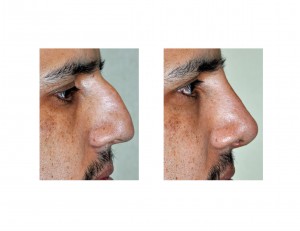Background: A bump or hump on a nose is a common reason a patient will seek rhinoplasty surgery. A smooth or straight dorsal line is one of the more important aspects of a pleasing nasal appearance. While some small bump reductions can be achieved by a simple shaving of the bone edge, this is the exception and is not what will work for most hump reductions.What makes up most humps is a combination of bone and cartilage as the hump occurs where the bone of the nose stops and the cartilage of the nose begins. Successful and sustained nasal hump reduction is usually a combination of both bone and cartilage removal.
While many rhinoplasty patients have small humps, there are some that have really large and prominent humps. These are usually associated with many types of ethnic noses. These large humps create a hooked nose appearance. The dorsal line of the nose has a very convex or almost mountaneous peak appearance in profile. The size of the hump is a sign of septal overgrowth and the nasal tip may be pushed down due to the amount of septal push on the nasal tip cartilages.
While some small hump reductions can be done by shaving or rasping and do not require breaking the bones of the nose, most larger hump reductions do. Taking off the cartilage and bone of the hump will leave a flat open-roof deformity. To change that open roof back to an inverted-V shape of a pleasing nasal bridge appearance, the sides of the roof or bone must move inward. This is what breaking or cutting the nose bones does. It is also the rhinoplasty maneuver that causes bruising and black eyes afterward. The nasal bones are cut down low and then pushed in to close the open roof. This will also make the upper part of the nose more narrow and less thick after a significant hump reduction.



Large nasal humps are part of many ethnic rhinoplasties and require significant cartilage and bone removal. Osteotomies are almost always needed due to the created open roof. Attention needs to be paid to potential narrowing of the middle vault when such large humps are reduced. Rather than discarding the upper edges of the upper lateral cartilages with the septal reduction, they can be preserved and used to keep width to the middle vault to keep/preserve straight dorsal lines from the frontal view.
Case Highlights:
1) Large nasal humps require bone and cartilage reduction/reshaping through an open rhinoplasty approach.
2) The amount of nasal hump reduction that a patient wants should be determined prior to surgery with computer imaging.
3) Dorsal hump reduction in men should achieve a straight line between the radix and the tip. In women more reduction may be desired in the upper third of the nose to create a more feminine appearance.
Dr. Barry Eppley
Indianapolis, Indiana


